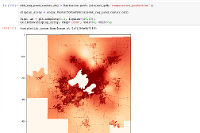Item (EBK Regression: Identify urban heat islands)
Item Card (XML) | Package Info| ID | 33f7e31abcb843979875501a28547bc2 |
| Item | Analyze_Urban_Heat_Using_Kriging.ipynb |
| Item Type | file |
| Owner | esri_notebook |
| Uploaded | Apr 25, 2019 |
| Modified | Apr 25, 2019 |
| Thumbnail |

|
| GUID | N/A |
| Name | N/A |
| Title | EBK Regression: Identify urban heat islands |
| Type | Notebook |
| Type Keywords | Notebook, Python |
| Description | The urban heat island effect is the tendency for city centers to have significantly higher temperatures than surrounding rural areas. You will interpolate temperature measurements to identify areas with both high temperatures and a high density of residents over the age of 65, who are at highest risk for heat-related illnesses. |
| Tags | EBK, Kriging, spatial interpolation, cross validation, model evaluation, prediction |
| Snippet | Interpolate temperature measurements to identify city areas with high temperatures and high density of residents. |
| Extent | N/A |
| Spatial Reference | N/A |
| Access Information | N/A |
| License Information | - Uses arcpy |
| Culture | english (united states) |
| Properties | {"notebookRuntimeName":"ArcGIS Notebook Python 3 Advanced","notebookRuntimeVersion":"10.7.1"} |
| Url | N/A |
| Proxy Filter | N/A |
| Last Modified | N/A |
| Size | 3073033 |
| Documentation | N/A |
| App Categories | N/A |
| Industries | N/A |
| Languages | N/A |
| Listed | false |
| Comments Enabled | true |
| # Comments | 0 |
| # Ratings | 0 |
| Avg. Rating | 0.0 |
| # Views | 209 |
| Categories | Data Science and Analysis |
| Content Status |
Child Resources: Comments Rating Groups Item Data Item Data as Zip Item Dependencies
Supported Operations: Add Comment Add Rating Delete Rating Related Items Share Item Unshare Item Package Item Set Item Content Status